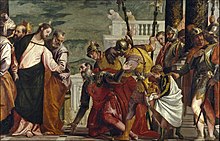Captain of Capernaum

The story of the captain of Capernaum can be found in the Gospel according to Matthew (8.5–13 EU ) - in the series of the healings and miracles of Jesus - and parallel to it in the Gospel according to Luke (7.1–10 EU ) but not in the Gospel John (4.46-54 EU ). Although John has parallels, he speaks of a slightly different story in Cana. The story tells of Jesus healing the servant of a centurion in Capernaum .
text
The text from 8.5-13 EU in the Gospel according to Matthew reads according to the standard translation :
5 When he came to Capernaum, a centurion approached him and asked him,
6 Lord, my servant lies at home paralyzed and in great pain.
7 Jesus said to him, I will come and heal him.
8 Then the centurion answered, Lord, I am not worthy of you going under my roof; but speak just one word and my servant will be well!
9 For I too must obey orders, and I myself have soldiers under me; If I now say to one: Go! then he goes, and to another: Come !, so he comes, and to my servant: Do that !, so he does it.
10 Jesus was amazed when he heard this and said to those who followed him, Amen, I say to you, I have never found such a faith in anyone in Israel.
11 I say to you, many will come from east and west and will sit at table with Abraham and Isaac and Jacob in the kingdom of heaven;
12 but the sons of the kingdom will be cast out into utter darkness; there will be howling and gnashing of teeth.
13 And to the centurion Jesus said, Go! It shall happen to you as you believed. And in the same hour his servant was healed.
Research on the two-source theory
Due partly literal match the story by Matthew and Luke in contrast to the illustration according Johannes is now generally believed that two evangelists existed a common source, namely the Q Source .
Interpretation aspects
The "captain" is referred to in the original text as ἑκατοντάρχης ( hekatontárchēs ), the Greek translation of the Latin centurion . He is a non-Jew, presumably in the service of Herod Agrippa. As a Torah-observing Jew, Jesus cannot enter his house. However, this does not limit the healing power of Jesus.
Whether the Greek word παῖς ( paĩs ) is correctly reproduced with “son” or with “servant” (standard translation) or “servant” (Luther Bible, Zurich Bible) is a matter of dispute . For “son” speaks that in v. 9 a slave is referred to as δοῦλος (doũlos), that Mt 2,16 uses παῖς in the sense of “child”, and this clearly in the similar story Mt 17,14-21 with παῖς the "son" is meant.
liturgy
Roman Catholic Church
In the holy mass the humble word of the pagan centurion (v. 8) is in a modified form the prayer of the believers before communion ; understanding it requires knowledge of the healing history: Lord, I am not worthy of you entering under my roof; but just speak one word and my soul will be healed.
The pericope in Luke's version is the Gospel on the 9th Sunday of the year ( reading year C ). The pericope of the “royal official whose son was sick” in the Gospel of John is scheduled as the gospel on Monday of the 4th week of Lent .
literature
- Uwe Wegner: The captain of Capernaum. JCB Mohr, Tübingen 1985, ISBN 3-16-144894-4 .
Individual evidence
- ↑ Gerhard Maier: The Gospel of Matthew . Ed .: Gerhard Maier, Rainer Riesner, Heinz-Werner Neudorfer, Eckhard J. Schnabel. SCM R. Brockhaus, Witten 2015, ISBN 978-3-417-29730-0 , p. 444 .
- ^ Matthias Konradt: The Gospel according to Matthäus, Göttingen 2015, p. 134.
- ↑ Ulrich Luz: The Gospel according to Matthew (Mt 8-17) , 3rd, revised edition, Zurich a. a. 1999, p. 14.
- ↑ Ulrich Luz: The Gospel according to Matthew (Mt 8-17) , 3rd, revised edition, Zurich a. a. 1999, p. 14. This means that interpretations that saw here an example of the solidarity of masters and servants can no longer be justified (ibid.). Likewise Matthias Konradt: The Gospel according to Matthäus , Göttingen 2015, p. 134. The possible translation with “servant” is “hardly” the right one at this point.
- ^ Archabbey of Beuron : 9th Sunday of the year C
- ↑ Archabbey of Beuron: Monday of the 4th week in Lent